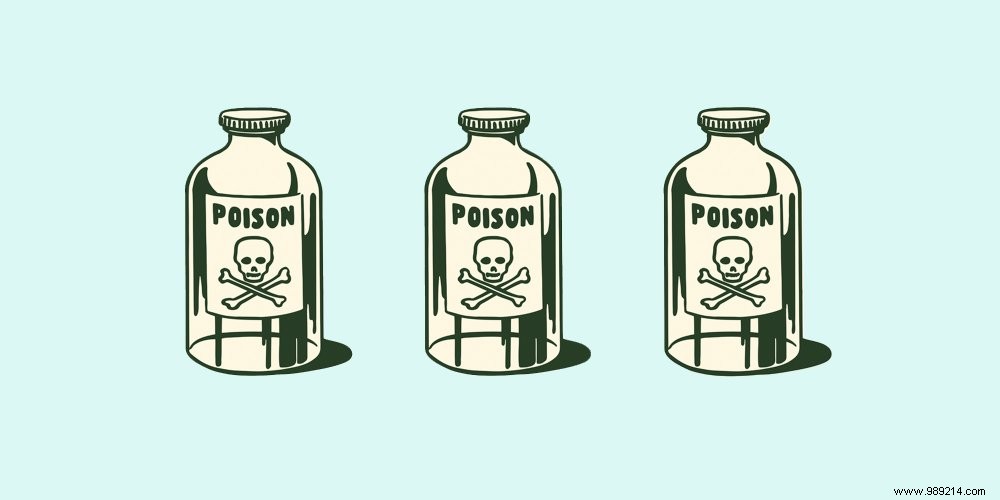 Allergies, breathing difficulties, drop in immunity, cancers… Many products that invade our homes contain substances very toxic, likely to erode our health capital.
Allergies, breathing difficulties, drop in immunity, cancers… Many products that invade our homes contain substances very toxic, likely to erode our health capital. Just because a product is authorized for sale does not mean that it is not dangerous. "Many everyday objects, seemingly harmless, contain chemical molecules whose effects are worrying", assures Professor Jean-François Narbonne, toxicologist, author of Sang pour sang toxic (ed. Thierry Souccar). They attack our mucous membranes, accumulate in the body and contribute in the long run to the appearance of diseases, sometimes serious.
No need, however, to fall into paranoia. You can clean up your environment by hunting down the most risky products. Our black list of objects to proscribe, in the current state of knowledge.
This powerful antibacterial agent is suspected of being an endocrine disruptor, which notably disrupts the functioning of the thyroid gland. A recent study by the National Institute for Medical Research (Inserm) suggests that it also induces behavioral problems in children.
Its use has been limited in Europe since 2017, but it is still found in some toothpastes, mouthwashes, shower gels and deodorants. Look for labels in stores to buy products that are exempt.
They allow you to cook without fat, but their coating contains perfluorinated compounds (the famous PFOA) which are considered carcinogenic. At low temperatures, these are harmless. But above 250°C, they degrade and migrate towards the food, especially if the pan is scratched. Prefer cast iron or ceramic.
They may contain bisphenol A (BPA), an endocrine disruptor that can contaminate food. Once ingested, "it is able to mimic the activity of estrogen produced naturally by the body, explains Professor Narbonne. Small amounts of BPA can be harmful to the reproductive, neurological and immune systems".
Hence a possible increase in the risk of diabetes or breast cancer. Turn over all your boxes and look at the number indicated in the recycling triangle. As a precaution, keep only those that display the number 2, 4 or 5. The others are at risk.
It can release metal particles that are toxic to the brain. So banish it from your kitchen. For your papillotes, opt for parchment paper, especially if you add lemon because the acidity increases the toxicity of heated aluminum.
Most are treated with perfluorinated flame retardant compounds, often bromine-based, which throw the hormonal system out of whack. By disrupting the development of the nervous system, they would also be the cause of many cases of autism, hyperactivity or attention deficit in children.
Pregnant women must be particularly vigilant because it has been proven that these toxins cross the placental barrier.
Their wood particles are very often glued together with urea formaldehyde resins which affect the eyes and the respiratory tract. Before buying a piece of furniture, carefully read its VOC label (volatile organic compounds), which will soon become mandatory for furniture as well as for construction and decoration products (paints, floors, etc.).
Some manufacturers already offer this information by indicating the amount of harmful emissions. Compare products. Those made of untreated raw wood, glass or metal are harmless.
Their plasticizers contain phthalates that are dangerous for the brain and the reproductive system. In little girls, these substances induce precocious puberty. And in young boys, they thwart the development of the testicles by inhibiting the production of testosterone, the male sex hormone.
Not to mention the risks of fetal malformations following regular exposure of the mother during pregnancy. Get rid of it as soon as possible.
The controversy is not settled but several scientific studies seem to show that they release ultrafine particles of paper, but also of silicon, bromine and chromium which can become embedded in the lungs.
According to the Institute for Materials Research in Berlin, these tiny dusts are the cause of headaches, breathing difficulties and heart problems. Ventilate the room where your printer is located twice a day.
They perfume the house pleasantly but 95% of them consist of synthetic products which pollute the indoor air, according to the Agency for the environment and energy management (Ademe). When burning, they release benzene and formaldehyde, which irritate the respiratory tract and can cause asthma attacks in allergy sufferers.
Inhaled in high doses, these substances also increase the risk of throat cancer. Incense sticks should be limited for the same reasons. Kick them out of your home or ventilate them for at least 15 minutes after each use.
They are considered harmless since they vaporize natural compounds. But as a survey of 60 million consumers showed (May 2018), many emit VOCs in sometimes high quantities. In addition, certain essential oils diffused by these products are irritating and allergenic, in particular those containing limonene, geraniol and linalool.
Thinking of doing yourself good, you therefore intoxicate yourself. It is better to abandon these aerosols and generously ventilate your home to renew the indoor air and get rid of bad smells.
Their synthetic fabric emits formaldehyde, a volatile organic compound harmful to health. In addition to the eye and respiratory irritations it causes, it creates allergic sensitizations likely to degenerate into asthma attacks. Since 2004, this gas has also been considered a "proven carcinogen for humans" by the International Agency for Research on Cancer (IARC).
T-shirts and sweatshirts adorned with glued designs or inscriptions also release phthalates, as do novelty toys and decorative objects made of polyvinyl chloride (PVC).
Read also: